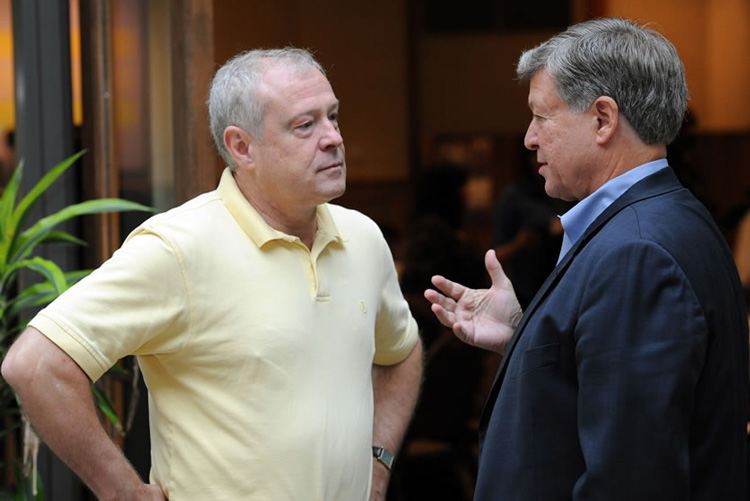
In my recent posts, we’ve been on a journey together to discover what your donor needs in order to commit to a meeting with you about your good cause.
Following the steps of the “commitment curve,” you have now identified the donor’s interests and passions, created general awareness on what your organization does that aligns with that passion, asked the donor what their specific interest is, and created desire or (at least) caused the donor to focus and take a second look at an area of specific interest for them.
Now the donor is on the path toward engagement, where they will be more receptive to a meeting. This engagement step is where you first bring up the idea of a meeting, while you continue to align the donor’s “deep gladness” to the program or project your organization does that addresses the world’s “deep hunger.” The closer this alignment, the better your chance of having a meeting. Why? Because the donor will want to know more about how to satisfy the need they feel.
Think about this.
Why would a donor want to meet with you, other than to find satisfaction for an interest or passion they have? Well, you could argue that they may feel an obligation, or they may be succumbing to your pressure. Let’s say that’s true. Where does that get you? Nowhere. Because there is no real alignment between you and the donor.
I say this so you pay close attention to the need for alignment. Don’t think you can skip over a step and somehow save time and energy. When you do that, you are doing your thing, but you’re going for the donor’s money and not truly serving the donor’s deep hunger – you are not addressing the very things they are interested in and passionate about.
You may notice this alignment blossoming sooner, back in the desire or interest stage of this commitment process. For instance, in any of the stages up to this point, the donor may express a desire to know more. That would be an opportunity for a meeting – one that you should take advantage of. So look for those opportunities.
 It’s not like you have to go through each of these stages before you ask for a meeting. No. You are looking for a meeting opportunity all along the way. And when it presents itself, you go for it. But be careful not to get ahead of the donor on this. Remember, you are serving the donor in this process, NOT serving yourself and your need to meet revenue goals.
It’s not like you have to go through each of these stages before you ask for a meeting. No. You are looking for a meeting opportunity all along the way. And when it presents itself, you go for it. But be careful not to get ahead of the donor on this. Remember, you are serving the donor in this process, NOT serving yourself and your need to meet revenue goals.
But for the sake of developing the logic and rationale of this commitment process, let’s say you have not been able to get a meeting up until now. There has not been a time when the donor signals that she wants to know more. That’s fine. Now is when you proactively ask for the meeting. Here is what that may sound like:
“NAME, it is so encouraging to know you care so much about [AREA OF INTEREST] here at [ORG NAME]. One thing you mentioned in our last communication [email, phone call] is that you and your husband are interested in [SUB-CATEGORY OF PROGRAM]. You know, just this week I heard a story coming out of that program. [Tell story of need or share anecdotal information]. Isn’t that something? There is so much to do! Anyway, I am going to be in your area on [DAY, DATE] and would like to stop in for 30 minutes maximum to give you more details on that program, and show you a short video. I think you’ll love it. Would you have some time that day to meet with me?”
And then work out the details; or if there is an objection to meeting on that day, ask: “Well, when would be a convenient time for you?” and accommodate their date. Or if they still don’t want to meet, then ask if you can email them the information. But only do this as a last resort, as your goal is to have a meeting.
Here’s the thing. If you’ve done the awareness, interest, and desire stages correctly, and with positive non-hurried energy, this meeting or engagement request should flow naturally. Trust will have been built. The donor will truly believe you are trying to serve their interests, and you will be on your way to getting that meeting.
Be aware that there will be instances where the donor still does not want to meet, or he still does not feel comfortable meeting. Read those signals from the donor and adjust. It could be that you need to provide more information and stories on how the donor’s gift will make a difference. Or you might uncover an important friend or business associate of your donor, who knows your cause well or is a current donor of your organization, who would be willing to meet with you and the donor. Or the donor may respond to your request to meet with your CEO or Executive Director.
The point is that the donor may be motivated to meet you under different circumstances or with someone higher up in the organization. Look for different ways to make this engagement happen. No matter what happens, remember that your sole objective in this whole system and process is to serve the donor and his or her interests and passions. If you keep this perspective, it will guide you on how you should respond to all the objections and options that will come your way.
In my next and final post on this subject, I will be writing about gaining the commitment and making the ask.
Richard
Series details:
- Introduction to series: Five Relationship Steps to Get Meetings
- Step 1: Creating Awareness
- Step 2: Identify Interest
- Step 3: Creating Desire
- Step 4: Cause Engagement (this post)
- Step 5: Get Commitment







0 Comments